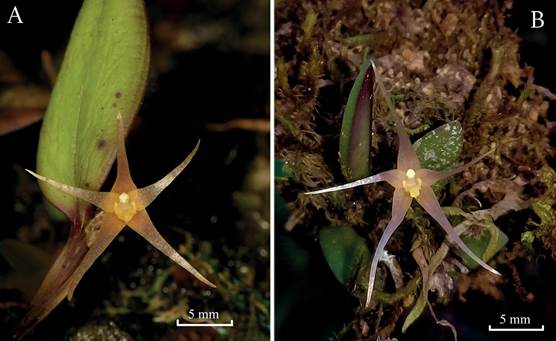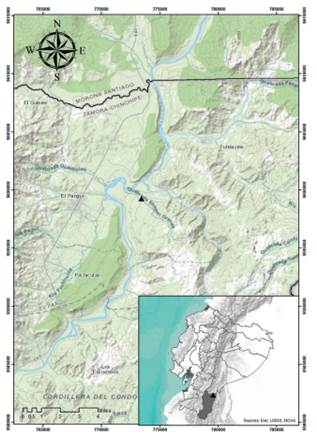Introduction
Octomeria R.Br. is a neotropical genus of Pleurothallidinae proposed by Robert Brown in 1813 when he described Octomeria graminifolia (L.) R.Br. (Pridgeon 2006, Luer 2010). According to previous molecular studies (Pridgeon et al. 2001, Pridgeon 2006), Octomeria is a monophyletic taxon. Plants of this genus are epiphytic, repent to caespitose. Leaves are conduplicate, flat to terete or semiterete; nevertheless, in some species the morphological boundaries are not clear. The flowers are fasciculate to solitary, emerging from the apex of the ramicaul. The sepals and petals are very similar, but unequal in size and the lateral sepals can be free or occasionally connate. The column is semiterete, usually with a sub- apical anther and stigma, the pollinarium is generally comprised of eight pollinia, except for one species (O. splendida Garay & Dunst.) which has only 6 pollinia (Cogniaux 1896, Luer 2010).
With approximately 160 species, Octomeria is distributed from Belize to northern Argentina, the center of diversity being from the Guianas to South Brazil (Forster 2007, Forster et al. 2012, Karremans et al. 2019). In Ecuador, 26 species of the genus are currently reported, of which, O. doucetteana L.E.Matthews, is the most recently described species for this country (Matthews 2018). In the Zamora Chinchipe province, there are eleven species registered (Luer 2010, 2011, Forster et al. 2012), which is the area with the highest diversity of the genus in the country. A recently discovered species from southeast Ecuador is described here.
Materials and methods
Plants of the new species were collected during a research on orchids of the Cordillera del Cóndor, under permits granted by the Ministerio del Ambiente de Ecuador. Some specimens were cultivated and photographed at the Orquideario La Paphinia in Zamora, Ecuador. Fresh flowers and inflorescences of live plants were stored in 70% ethanol and glycerol. Measurements of the vegetative and floral parts were made from living and alcohol stored material.
Digital images were taken with a Panasonic® FZ300 camera with a Raynox DCR-150 50 mm lens; also, with a Canon® EOS 1100D camera with an EFS 18-58 mm lens and approximation lenses +10 Kernel Pro Optics 58 mm.
The taxonomic revision of Octomeria by Luer (2010) and other original descriptions from holotypes of related species (Hoehne 1950, Santos et al. 2020) were consulted and compared.
Taxonomic treatment
Octomeria candidae Vélez-Abarca, M.M.Jiménez & Baquero sp. nov. (Fig.1-4).
TYPE: Ecuador. Zamora Chinchipe: Cordillera del Cóndor flank, 890 m, 18 February 2020, L. Vélez LV0004 (holotype: ECUAMZ!)
Diagnosis: Similar to Octomeria estrellensis Hoehne, from which it differs by the short, repent rhizome, the longer ramicauls, the narrowly ovate, long-acuminate dorsal sepal; and the yellow lip concave below the middle.
Plant small up to 8 cm tall, epiphytic, shortly repent. Rhizome stout, 5 mm thick, 0.5-1.0 cm long between ramicauls. Roots ca. 0.5 mm in diameter, flexuous, white. Ramicauls slender, erect, 0.5-5.0 cm long, cylindrical, with 1-3 internodes enclosed by loose, tubular, sheaths, which are torn with age. Leafs sometimes suffused with purple abaxially and at the edges of the adaxial part, erect, coriaceous, fleshy, elliptical to narrowly ovate, 1.5-4.0 × 0.8-1.2 cm, the midvein sulcate adaxially and carinate abaxially, margin entire, cuneate at the base into a petiole, 3 mm long. Inflorescence of a single flower, rarely 2 simultaneous, produced successively from the apex of the ramicaul; peduncle terete, 2.5-3.0 mm long; floral bract 1 infundibuliform, membranaceous, 2.5-3.0 mm long; pedicels cylindrical, 3 mm long; ovary 2 mm long, somewhat obconical, sulcate and slightly curved. Sepals and petals translucent pink to orange, free, glabrous. Dorsal sepal lanceolate, long-acuminate, 1.0-1.2 × 0.2-0.3 cm, 3-veined. Lateral sepals lanceolate, falcate, long-acuminate, 1.0-1.2 × 0.1-0.2 cm, 3-veined. Petals narrowly ovate, long-acuminate, 1.0-1.2 × 0.2-0.3 cm, 3-veined. Lip yellow, oblong, panduriform, trilobed, glabrous, 3.0 × 1.5 mm, with lateral lobes erect, rounded, the apical lobe ovate, slightly thickened above the middle, concave below the middle; base truncate, not articulated to the column foot. Column semiterete, 2 mm long, foot 1.5 mm long, stigma ventral, clinandrium entire, margin slightly dentate. Anther cap subapical. Pollinia 8, in 2 sets of 4, yellow, clavate.
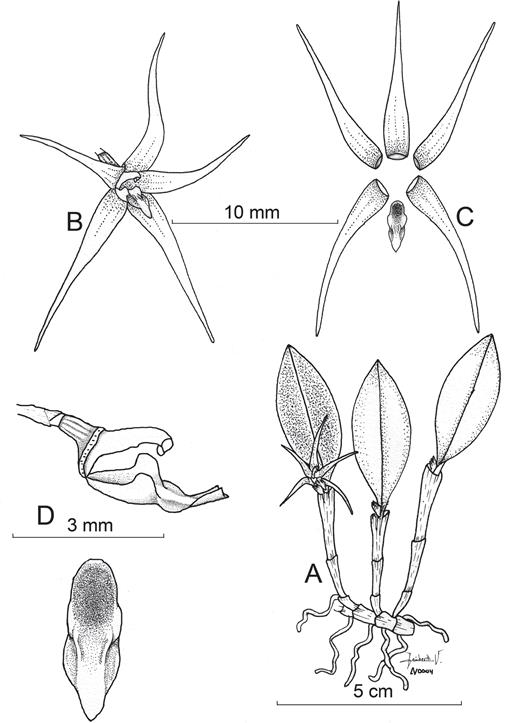
A. Habit.
B. Flower in 3/4 view.
C. Dissected perianth.
D. Part of the pedicel, ovary, column and lip in lateral view and lip dorsal view.
Illustration by Leisberth Vélez-Abarca, based on the holotype, Vélez-Abarca LV-0004 (ECUAMZ).
Figure 1 Octomeria candidae Vélez-Abarca, M.M.Jiménez & Baquero.
Distribution and habitat
The holotype of this species was found in a flank of the Cordillera del Cóndor, located in the Zamora Chinchipe Province, Ecuador. The species is found between 890-980 m in low premontane forests on sandstone plateaus. The species grows as an epiphyte on branches of trees and shrubs of Dacryodes peruviana (Loes.) H.J.Lam, (Burseraceae) and Schefflera sp. (Araliaceae).
Octomeria candidae is morphologically similar and presumably related to species in sect. Octomeria subsect. Octomeria (sensuLuer 1986): O. cochlearis Rchb.f. (Reichenbach 1881), O. montana Barb. Rodr. (Barbosa Rodrigues 1882) O. ochroleuca Barb.Rodr (Barbosa Rodrigues 1877), O. lilliputana W.Forst., F.Barros & V.C.Souza (Foster et al. 2013) and O. estrellensis Hoehne (Hoehne 1950), the latter being the most similar species, which is characterized by being the only small species known to have fleshy, obovate to elliptical leaves and an elongated peduncle. However, O. candidae is the second known species in the genus to share these characteristics. Despite the fact that both species are similar, O. candidae is distributed in southern Ecuador, and O. estrellensis is distributed further south in Brazil. Octomeria candidae is distinguished from O. estrellensis by the short repent habit, thicker rhizome (vs. caespitose habit, inconspicuous rhizome), the longer ramicauls, 5-50 mm long (vs. 5-10 mm long), the shorter pedicels, 3 mm long (vs. 5 mm long), the dorsal sepal narrowly ovate, long-acuminate (vs. oblong- lanceolate, acute to acuminate), the petals narrowly ovate, long-acuminate (vs. oblong-lanceolate, acute to acuminate), and the yellow lip, concave below the middle, acute at the apex (vs. the red-purple at the base and center, and greenish yellow at the apical third, acute to rounded at the apex) (Fig. 2).
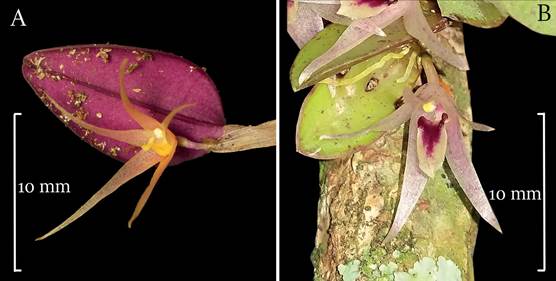
A. Flower of O. candidae in situ.
B. Flower of O. estrellensis in cultivation.
Photos by Marco M. Jiménez (A) and Marcos Da Silva (B).
Figure 2 Comparison of flowers of Octomeria candidae Vélez-Abarca, M.M.Jiménez & Baquero and O. estrellensis Hoehne.
In the study area, a considerable population of Octomeria candidae was found, which expresses high vegetative variability. The individuals that were found under shade showed greater vegetative development, since they have more elongated ramicauls, larger and wider leaves, and green on the adaxial and abaxial surfaces (Fig. 3B). While those that receive direct sunlight in more degraded areas are smaller, they present a purplish-red pigmentation in the abaxial and adaxial side of the leaves, in some cases only abaxially (Fig. 3C). The flowers of individuals exposed to greater solar radiation have a larger size compared to the flowers of those that are under shade (Fig. 4).
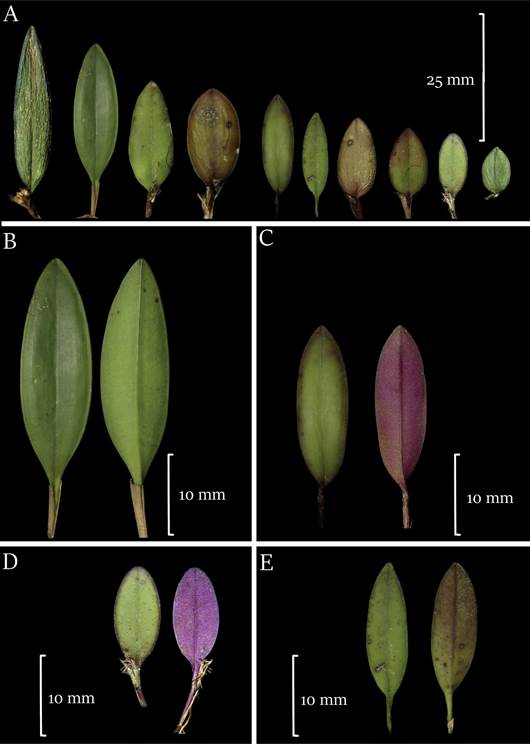
A. Variation in length, width and shape of the leaf blade, adaxial side.
B. Adaxial and abaxial side of leaves with light coloration.
C. Adaxial and abaxial side with green and light purple red, respectively and dark edges.
D. Adaxial and abaxial side with intense green and purple red, respectively, in addition to having a completely obtuse apex.
E. Blade adaxially green with dark edges and abaxially partially dark.
Photos by Marco M. Jiménez and Leisberth Vélez-Abarca
Figure 3 Morphological and color variation in leaves of Octomeria candidae.
Conservation status
This species has not been found yet in other localities of Ecuador, currently reported only in the province of Zamora Chinchipe (Fig. 5). The known populations of this species grow in disturbed forests where mining activity is practiced. Because of the considerable presence (1-10) of individuals per phorophyte observed, future problems due to destruction of the habitat are expected for this species since it has only been found outside of protected areas.












 uBio
uBio 
